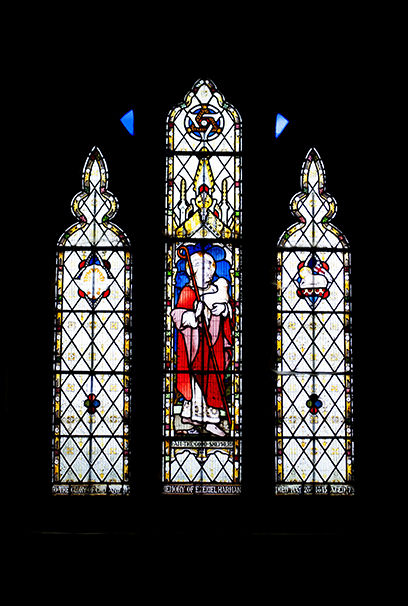The east window of the parish church at Southease consists of three lights. The centre light contains a full figured "Good Shepherd" within a canopy and the two side lights contain emblems Dove, in the left panel and Agnus Dei in the right, against backgrounds of attractively decorated diamond quarries. The two side lights are not Grisaille as stated in Robert Eberhard's survey of Church Stained Glass Windows.
The window probably dates from between 1850 and 1860 and is most likely by William Wailes of Newcastle upon Tyne (1809-1881). William Wailes was one of the most prolific and renowned stained glass makers of the 19th century and further examples of his work can be seen at the local parish churches of Rodmell, Iford and Telscombe, the latter also depicting the good shepherd. As records of Wailes work do not exist, it is not possible to confirm this at present.
The condition of the window at Southease is not good. There has been serious loss of detail due to unstable pigment (glasspaint). This vitreous paint comprises finely powdered glass, metallic oxide, oil or water plus a fluxing ingredient to control melting temperatures. After thorough grinding the paint is applied to the glass by brush. The pieces of glass are then fired in a kiln (to around 600 degrees centigrade) fusing the paint onto the surface, forming permanent detail/decoration. Unfortunately, some glasspaints failed to fuse properly, due to incorrect formulation or underfiring. This is a fairly common problem with 19th century painted glass, and there is no cure.
The window at Southease also bears the inscription:
TO THE GLORY OF GOD AND IN MEMORY OF EZEKIEL HARMAN, DIED 28th MAY 1845 AGED 73
But who was Ezekiel Harman and what, if any connection, does he have with the parish of Southease in East Sussex?
Ezekiel Harman was born on the 18th February 1773 in Paradise Row, Stoke Newington, the son of Elizabeth Dickinson and Jeremiah Harman, a linen draper. The Dickinson family to which his mother belonged, were wealthy merchants with plantations in Jamaica, the family fortune having been established by Captain Francis Dickinson (1632-1704), the son of the Rev William Dickinson. Captain Francis, in return for his gallant conduct when Jamaica was taken from the Spaniards in 1655 by the forces under Admiral Penn and General Venables, was granted 6000 acres there.
Francis' elder brother, Edmund Dickinson, (1642-1707), was physician to both Charles II & James II.
The family fortune and estates were further increased and added to by Francis' son Caleb and in turn by his three sons, Ezekiel, (1712-87), Caleb, (1716-83) and Vickris (1718-c 1785). Caleb's only son William married, in 1771, Philippa Fuller, a cousin of 'Mad Jack' Fuller of Brightling. William succeeded his wife's uncle, Rose Fuller, as MP for Rye in 1777.
Ezekiel Dickinson married in 1736 Frances Barnard, the daughter of Thomas Barnard who had, in the previous year of 1735, acquired the lordship of the manor of Southease cum Heighton.
On the death of Thomas Barnard the title passed to his son-in-law Ezekiel Dickinson, then in turn to Ezekiel's son Barnard and to Barnard's widow Elizabeth. Barnard and Elizabeth having died childless, the title passed to Barnard's nephew, Jeremiah Harman, then to Jeremiah's younger brother Ezekiel Harman, (to whose memory the window is dedicated) and in turn to his son, the Rev John Harman. The rev. John Harman sold the title and lands to William Langham Christie in 1870 and the title remains with the Christie family.
Ezekiel Harman appears to have spent his early life at the family home established by his Grandfather Ezekiel Dickinson, at Bowden Park, Wiltshire, where he was a neighbour of William Henry Fox Talbot of Lacock Abbey. There are a large number of references to Ezekiel in the Fox Talbot correspondence collection and from these it would appear that he was very active in the community, being instrumental in having his friend, John McAdam, provide some of his men to assist in improving the local roads in 1833. He was also one of two guarantors of the 500 pounds required to build the new workhouse at Lacock in 1833, and was involved in persuading Fox Talbot to make available 12 acres of arable farming land on the Lacock Abbey estate to enable the poor of the parish to raise their own food.
There are less flattering stories regarding Ezekiel. It was suggested in 1826, by which time Ezekiel was resident at Theobalds Park, Cheshunt, Hertfordshire, that he intended to sell Bowden Park despite his aunt, Elizabeth Dickinson still living there and having been bequeathed the property for life under the terms of her husband Barnard's will. Bowden Park was eventually sold in 1845, on Ezekiel's death under the terms of his will.
In a letter from Charles Feilding, (1780-1837), Rear Admiral and Fox Talbot's step-father, to Fox Talbot, he describes Ezekiel Harman as 'really not a person to have anything to do with.'
Ezekiel Harman died at his home, Theobalds Park, Cheshunt, Hertfordshire on 28th May 1845.
At this stage in the research the most likely explanation for the origin of the window is that it was commissioned by the Rev John Harman in memory of his father sometime between the latter's death in 1845 and the sale of the title in 1870. The rev. John Harman was vicar of St. James, Enfield and chaplain to the Royal Small Arms Factory.
